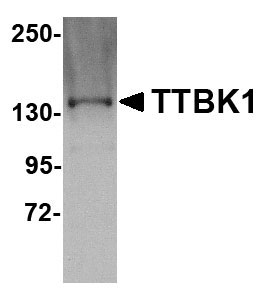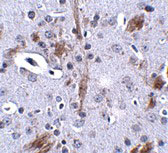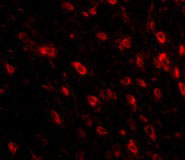TTBK1 Antibody
- 产品详情
- 实验流程
- 背景知识
Application
| WB, IF, E, IHC-P |
|---|---|
| Primary Accession | Q5TCY1 |
| Other Accession | Q5TCY1, 97203020 |
| Reactivity | Human, Mouse |
| Host | Rabbit |
| Clonality | Polyclonal |
| Isotype | IgG |
| Calculated MW | 142737 Da |
| Concentration (mg/ml) | 1 mg/mL |
| Conjugate | Unconjugated |
| Application Notes | TTBK1 antibody can be used for detection of TTBK1 by Western blot at 1 µg/mL. Antibody can also be used for immunohistochemistry starting at 2.5 µg/mL. For immunofluorescence start at 20 µg/mL. |
| Gene ID | 84630 |
|---|---|
| Other Names | Tau-tubulin kinase 1, 2.7.11.1, Brain-derived tau kinase, TTBK1, BDTK, KIAA1855 |
| Target/Specificity | TTBK1; Multiple isoforms of TTBK1 are known to exist. This antibody is predicted to not cross-react with TTBK2. |
| Reconstitution & Storage | TTBK1 antibody can be stored at 4℃ for three months and -20℃, stable for up to one year. As with all antibodies care should be taken to avoid repeated freeze thaw cycles. Antibodies should not be exposed to prolonged high temperatures. |
| Precautions | TTBK1 Antibody is for research use only and not for use in diagnostic or therapeutic procedures. |
| Name | TTBK1 |
|---|---|
| Synonyms | BDTK, KIAA1855 |
| Function | Serine/threonine kinase which is able to phosphorylate TAU on serine, threonine and tyrosine residues. Induces aggregation of TAU. |
| Cellular Location | Cytoplasm. |
| Tissue Location | Expressed in the brain, particularly in cortical and hippocampal neurons. Weakly expressed in spinal cord and testis. No expression in adipose tissue, bladder, cervix, colon, esophagus, heart, kidney, liver, lung, ovary, placenta, prostate, skeletal muscle, small intestine, spleen, testis, thymus, thyroid or trachea |
For Research Use Only. Not For Use In Diagnostic Procedures.
Provided below are standard protocols that you may find useful for product applications.
BACKGROUND
TTBK1 Antibody: Tau tubulin kinase (TTBK1) belongs to the casein kinase 1 superfamily and is involved in the phosphorylation of specific serine/threonine residues in paired helical filaments of the tau protein. It is specifically expressed in the brain and induces tau aggregation in human neuronal cells in a dose-dependent manner. TTBK1 levels have been found to be upregulated in the brains of Alzheimer's disease (AD) patients, and mice expressing human TTBK1 protein showed significant age-dependent memory impairment. These mice displayed increased levels of the CDK5 activators p25 and p35, and reduced levels of the NMDA receptor types 2B and 2D, suggesting that TTBK1 may play a role in memory dysfunction in AD patients.
REFERENCES
Sato S, Cerny RL, Bueschner JL, et al. Tau-tubulin kinase 1 (TTBK1), a neuron-specific tau kinase candidate, is involved in tau phosphorylation and aggregation. J. Neurochem. 2006; 98:1573-84.
Sato S, Xu J, Okuyama S, et al. Spatial learning impairment, enhanced CDK5/p35 activity, and downregulation of NMDA receptor expression in transgenic mice expressing tau-tubulin kinase 1. J. Neurosci. 2008; 28:14511-21.
终于等到您。ABCEPTA(百远生物)抗体产品。
点击下方“我要评价 ”按钮提交您的反馈信息,您的反馈和评价是我们最宝贵的财富之一,
我们将在1-3个工作日内处理您的反馈信息。
如有疑问,联系:0512-88856768 tech-china@abcepta.com.























 癌症的基本特征包括细胞增殖、血管生成、迁移、凋亡逃避机制和细胞永生等。找到癌症发生过程中这些通路的关键标记物和对应的抗体用于检测至关重要。
癌症的基本特征包括细胞增殖、血管生成、迁移、凋亡逃避机制和细胞永生等。找到癌症发生过程中这些通路的关键标记物和对应的抗体用于检测至关重要。 为您推荐一个泛素化位点预测神器——泛素化分析工具,可以为您的蛋白的泛素化位点作出预测和评分。
为您推荐一个泛素化位点预测神器——泛素化分析工具,可以为您的蛋白的泛素化位点作出预测和评分。 细胞自噬受体图形绘图工具为你的蛋白的细胞受体结合位点作出预测和评分,识别结合到自噬通路中的蛋白是非常重要的,便于让我们理解自噬在正常生理、病理过程中的作用,如发育、细胞分化、神经退化性疾病、压力条件下、感染和癌症。
细胞自噬受体图形绘图工具为你的蛋白的细胞受体结合位点作出预测和评分,识别结合到自噬通路中的蛋白是非常重要的,便于让我们理解自噬在正常生理、病理过程中的作用,如发育、细胞分化、神经退化性疾病、压力条件下、感染和癌症。








